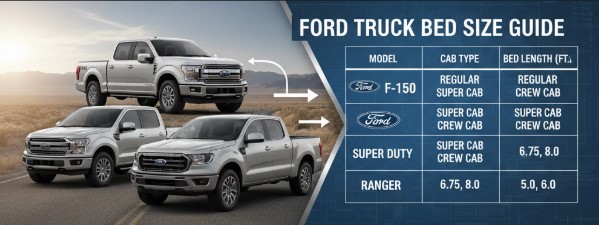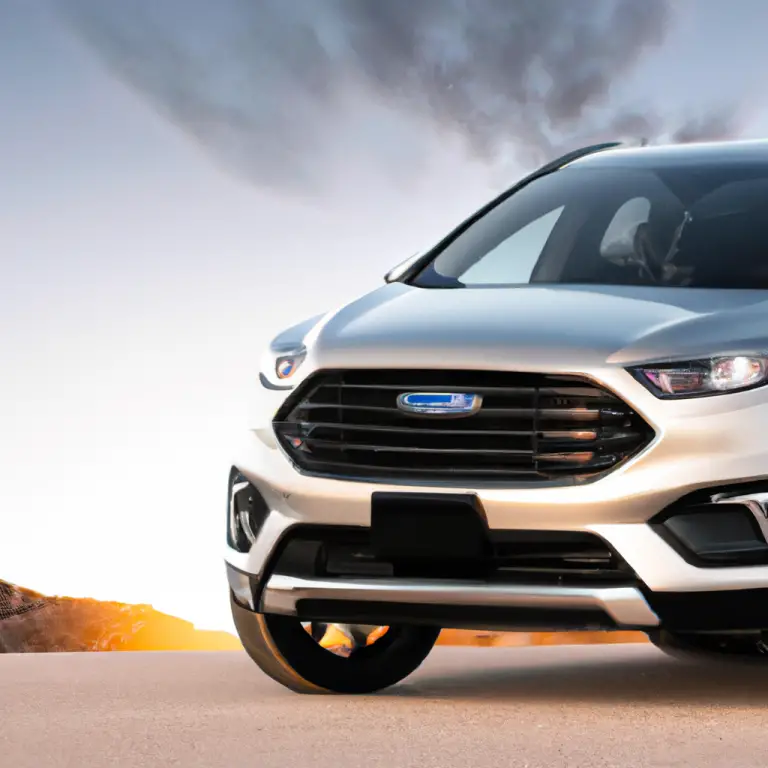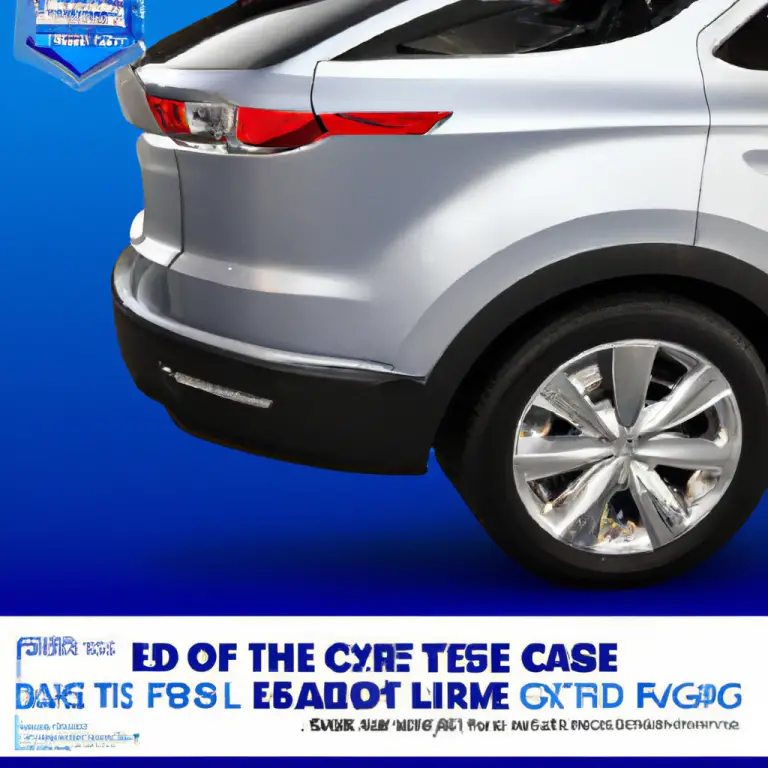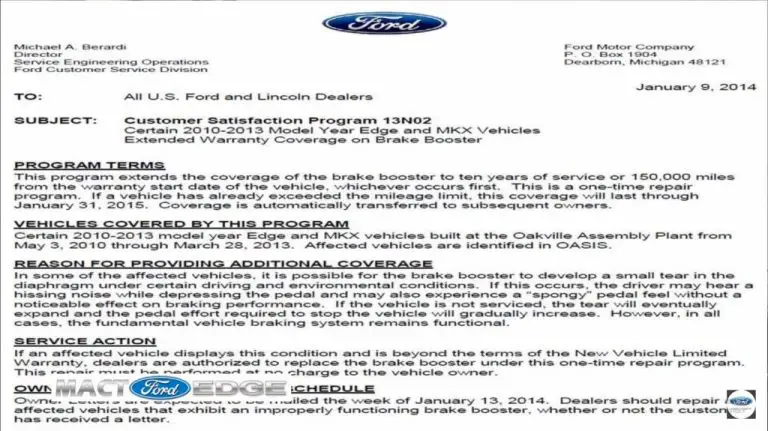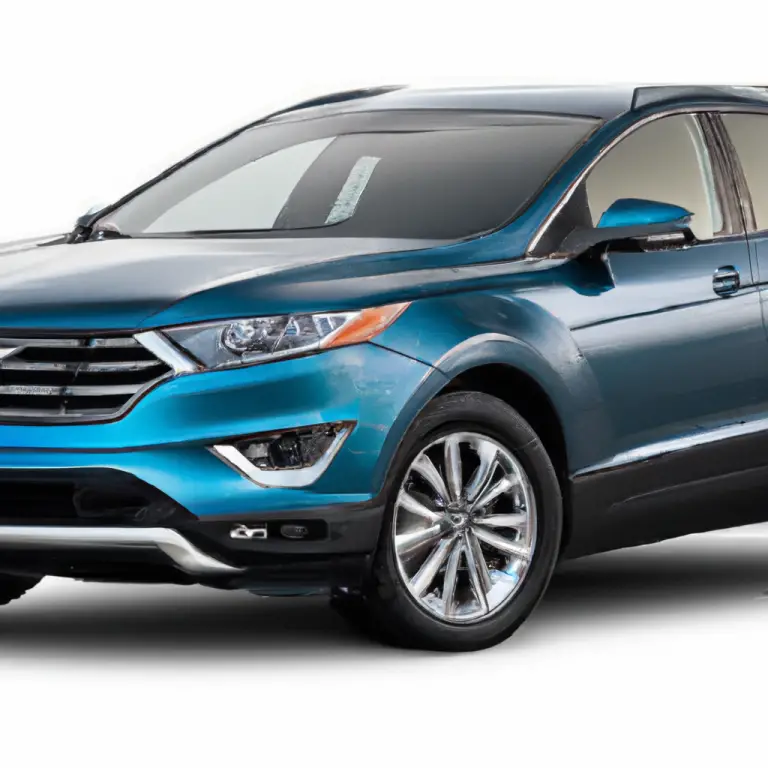The Complete Ford Truck Bed Size Chart (2025 Dimensions Guide)
Choosing the right Ford truck often comes down to one critical question: how much can it carry? From the compact Maverick designed for urban utility to the formidable Super Duty built for the toughest jobs, Ford offers a diverse lineup where the cargo bed is central to its purpose. Understanding the specific dimensions and capabilities of each model is the first step in matching a truck to your work and lifestyle demands.
This guide provides a comprehensive, data-driven look at the bed sizes available across the entire 2025 Ford truck family. To begin, the following chart offers a high-level comparison of each model, allowing you to quickly identify which trucks align with your cargo and payload requirements.1
Master Ford Truck Bed Comparison Table (2025 Models)
| Model | Class | Available Bed Sizes (Nominal) | Max Available Payload (lbs) |
| Ford Maverick | Compact | 4.5-ft | 1,500 |
| Ford Ranger | Mid-Size | 5-ft | 1,805 |
| Ford F-150 | Full-Size (Half-Ton) | 5.5-ft, 6.5-ft, 8-ft | 2,445 |
| Ford F-250 Super Duty | Full-Size (Heavy-Duty) | 6.75-ft, 8-ft | 4,268 |
| Ford F-350 Super Duty | Full-Size (Heavy-Duty) | 6.75-ft, 8-ft | 8,000 (DRW) |
The Ultimate Ford Truck Bed Size Chart
F-150, Super Duty, Ranger, & Maverick Specs
Why Does Bed Size Matter?
Choosing the right Ford truck involves more than just engine power and cab size; the truck bed is where the work gets done. Whether you’re hauling construction materials, loading up for a weekend adventure, or just helping a friend move, the bed’s length, width, and overall volume are critical. This guide breaks down the bed sizes across Ford’s entire truck lineup, from the compact Maverick to the heavy-duty F-350.
Ford F-150 Bed Sizes (The Bestseller)
The Ford F-150 offers the most versatility, with three different bed lengths, often referred to as Short Box, Standard Box, and Long Box. The bed you can get is directly tied to the cab style you choose (Regular, SuperCab, or SuperCrew). As the chart below shows, the 8.0-foot bed offers significantly more cargo volume, but is typically limited to Regular and SuperCab models for commercial use.
Key Takeaway: The 6.5-foot bed is a popular compromise, offering 18% more volume than the 5.5-foot bed, and is available on the roomy SuperCrew cab.
How to Measure a Truck Bed
When comparing, you’ll see three key measurements:
Super Duty (F-250/F-350) Beds
Ford’s Super Duty trucks are built for heavy hauling and towing. They simplify the options to two long-bed configurations: a 6.75-foot bed and an 8-foot bed. Your choice is primarily dictated by the cab style. The donut chart shows the flexibility: Regular Cabs are work-focused and come only with the 8-foot bed, while SuperCab and Crew Cab models offer both bed sizes.
Ranger & Maverick Beds
Ford’s smaller trucks, the mid-size Ranger and compact Maverick, have more streamlined offerings. The 2024 Ford Ranger comes exclusively with a 5-foot bed paired with a SuperCrew cab, offering a total cargo volume of:
The Maverick’s 4.5-foot bed may seem small, but its key feature is the “FLEXBED” system, which allows for versatile customization. As the chart shows, the bed lengths clearly delineate the three truck classes.
Ford Truck Bed Dimensions (At-a-Glance)
Here is the complete data chart comparing the key dimensions for the standard bed options across the 2024 Ford truck lineup. Measurements are in inches unless noted.
| Model / Bed | Length (ft) | Length (in) | Width (wheelhouse) | Volume (cu ft) |
|---|---|---|---|---|
| Maverick (4.5 ft) | 4.5 | 54.4 | 42.6 | 33.3 |
| Ranger (5 ft) | 5.0 | 61.0 | 48.2 | 43.5 |
| F-150 (5.5 ft) | 5.5 | 67.1 | 50.6 | 52.8 |
| F-150 (6.5 ft) | 6.5 | 78.9 | 50.6 | 62.3 |
| F-150 (8 ft) | 8.0 | 97.6 | 50.6 | 77.4 |
| Super Duty (6.75 ft) | 6.75 | 81.9 | 50.5 | 65.4 |
| Super Duty (8 ft) | 8.0 | 98.1 | 50.5 | 78.5 |
Choosing the Right Bed Size
Understanding your truck’s bed size is crucial for maximizing its payload capacity and for daily utility. If you primarily use your truck as a family vehicle, the F-150 SuperCrew with a 5.5-foot bed is a comfortable and capable choice. If you’re a contractor, an F-250 with an 8-foot bed is a mobile workshop. For city dwellers who need occasional utility, the Maverick’s FLEXBED is a game-changer.
Once you’ve chosen a size, don’t forget to outfit it. Check out our guide to the best truck bed organizers to make the most of the space.
Frequently Asked Questions
What is a “Styleside” vs. “Flareside” bed?
“Styleside” is Ford’s term for a standard truck bed where the side walls are smooth from the cab to the tailgate. “Flareside” (or “Stepside”) was an older style with flared fenders and a step behind the cab. All modern Ford trucks (F-150, Ranger, etc.) use the Styleside design.
Does the F-150 Lightning have a different bed?
Yes. The all-electric F-150 Lightning is available *only* with the 5.5-foot bed, paired exclusively with the SuperCrew cab. It also features the “Mega Power Frunk” for extra sealed storage.
What is the Ford “FLEXBED”?
The Maverick’s 4.5-foot bed is called the FLEXBED. It’s designed for DIY customization with slots to fit 2x4s or 2x6s, allowing you to create multi-level storage or bike racks. It also features multiple tie-downs and pre-wired 12-volt power sources.
Sources
How to Measure a Truck Bed: A Practical Guide
While manufacturer specifications provide accurate dimensions for new vehicles, measuring a truck bed yourself is essential when buying accessories like tonneau covers, bed liners, or toolboxes where a precise fit is critical. It’s also a crucial step when assessing a used truck to confirm its original configuration.
The process is straightforward and requires only a tape measure.
Diagram of Truck Bed Measurement Points
A simple line drawing of a pickup truck bed from a top-down and side-view perspective. Arrows clearly indicate the start and end points for measuring: 1) Length (Bulkhead to Tailgate), 2) Width (Rail to Rail), 3) Width Between Wheelhouses, and 4) Depth (Floor to Rail).
- Step 1: Measure Bed LengthPlace the end of your tape measure against the interior wall of the bulkhead (the front wall of the bed, closest to the cab). Extend the tape along the top of the bed rail until you reach the inside edge of the closed tailgate. This measurement in inches is the most common dimension used to identify a bed’s size.5 To convert to feet, simply divide the number of inches by 12.
- Step 2: Measure Bed WidthTwo width measurements are important. First, measure the distance between the top of the bed rails from side to side for the maximum width. Second, and more critically for hauling flat materials, measure the distance between the interior wheel wells. This is the narrowest point of the bed floor and determines whether items like 4×8 sheets of plywood can lie flat.3
- Step 3: Measure Bed DepthMeasure vertically from the bed floor to the top of the bed rail. This dimension, also called bed height, determines how much cargo volume is available below the rails.3
For those looking to purchase specific accessories or needing to calculate cargo volume precisely, a more detailed guide on how to measure a truck bed is available here.
2025 Ford F-150 Bed Sizes & Dimensions
As America’s best-selling truck for decades, the Ford F-150’s immense popularity is rooted in its incredible versatility. This adaptability is largely defined by its wide array of cab and cargo bed combinations, allowing buyers to configure a truck that perfectly suits their needs, whether for work, family, or recreation.7
For 2025, the F-150 is available with three distinct cargo box sizes, traditionally known as the short, standard, and long beds. These are paired with three different cab styles, each offering a different balance of passenger and cargo space.
- Bed Options: 5.5-foot, 6.5-foot, and 8-foot Styleside beds.9
- Cab Options:
- Regular Cab: A single-row cab with two doors, seating up to three people.
- SuperCab: A two-row cab seating up to six, with smaller, rear-hinged back doors for occasional passenger use.
- SuperCrew: The largest cab, seating up to six with four full-size, front-hinged doors and the most rear-seat legroom, making it ideal for families.7
The most critical factor for potential F-150 owners to understand is that not all bed sizes are available with all cab styles. The choice of cab directly dictates the available bed lengths, a decision driven by the vehicle’s wheelbase and overall length to maintain safe handling and maneuverability.12 This creates a fundamental trade-off: a buyer cannot configure an F-150 with both the most spacious cab (SuperCrew) and the longest cargo bed (8-foot). This is because such a combination would require an exceptionally long wheelbase, making the truck difficult to drive in normal conditions. Therefore, buyers must prioritize either maximum passenger comfort or maximum cargo length.
The following table breaks down the precise dimensions for each F-150 bed and clarifies which cab styles each can be paired with.9
2025 Ford F-150 Bed Dimensions & Cab Compatibility Table
| Bed Size (Nominal) | Length (in) | Width (between wheelhouses, in) | Bed Depth (in) | Cargo Volume (cu. ft.) | Available Cab Styles |
| 5.5-Foot Box | 67.1 | 50.6 | 21.4 | 52.8 | SuperCrew |
| 6.5-Foot Box | 78.9 | 50.6 | 21.4 | 62.3 | Regular Cab, SuperCab, SuperCrew |
| 8-Foot Box | 97.6 | 50.6 | 21.4 | 77.4 | Regular Cab, SuperCab |
2025 Ford Super Duty (F-250/F-350) Bed Sizes & Dimensions
When the job requires moving beyond the capabilities of a half-ton truck, the Ford Super Duty series (F-250, F-350, and F-450) steps in. These trucks are engineered for extreme towing and hauling, and their cargo beds are built to withstand the rigors of commercial use with higher payload capacities and more robust construction.1
The Super Duty lineup simplifies the bed choices to two options: a standard-length 6.75-foot box and a full-size 8-foot long box. Similar to the F-150, these bed options are linked to the three available cab styles: Regular Cab, SuperCab, and the four-door Crew Cab.15
- 6.75-Foot Bed: This bed is available only with the larger SuperCab and Crew Cab configurations.15
- 8-Foot Bed: The long bed offers maximum utility and is available across all three cab styles, allowing for a work-focused Regular Cab configuration with the largest possible cargo box.15
A crucial distinction often overlooked is that a Super Duty bed is not identical to an F-150 bed of the same nominal length. While the length and width between the wheelhouses are similar, the Super Duty’s bed is significantly wider overall, with bed walls that are pushed further out.15 This results in greater total cargo volume—the 8-foot Super Duty bed offers 78.5 cubic feet of space compared to the F-150’s 77.4 cubic feet.13 This extra space is a key design element for accommodating heavy-duty equipment, fifth-wheel and gooseneck hitches, and the bulkier cargo common in professional trades. This also means that accessories like drop-in bed liners are not interchangeable between F-150 and Super Duty models.
The table below provides the detailed dimensions for the 2025 Super Duty beds.14
2025 Ford Super Duty Bed Dimensions Table
| Bed Size (Nominal) | Length (at floor, in) | Max Width (in) | Width (between wheelhouses, in) | Bed Depth (in) | Cargo Volume (cu. ft.) |
| 6.75-Foot Box | 81.9 | 66.9 | 50.5 | 21.1 | 65.4 |
| 8-Foot Box | 98.1 | 66.9 | 50.5 | 21.1 | 78.5 |
2025 Ford Ranger Bed Size & Dimensions
The Ford Ranger has undergone a significant transformation in its latest generation. Beginning with the 2024 model year, Ford streamlined the Ranger’s offerings for the U.S. market, simplifying the configuration choices for buyers.17 For 2025, this simplified approach continues: every Ford Ranger model, from the base XL to the high-performance Raptor, is sold exclusively in one configuration: a four-door SuperCrew cab paired with a 5-foot cargo bed.18
The previous generation’s options, which included a longer 6-foot bed available with the smaller SuperCab, have been discontinued for new models.20 This change signals a clear strategic shift for the Ranger. By standardizing on the more passenger-focused SuperCrew cab and a versatile but shorter bed, Ford is positioning the Ranger as a “lifestyle” truck. This configuration is perfectly suited for recreational activities like hauling mountain bikes or camping gear, as well as for daily driving where maneuverability is key. Customers who require a longer bed for commercial purposes are now guided toward the base models of the F-150, clarifying the distinct roles of each truck in Ford’s lineup.
Despite its single-size offering, the Ranger’s bed is highly functional. A key engineering achievement is its width of 48.2 inches between the wheelhouses, allowing it to be one of the few mid-size trucks capable of carrying a 4×8 sheet of plywood flat on the floor.19
2025 Ford Ranger Bed Dimensions Table
| Bed Size (Nominal) | Length (in) | Width (between wheelhouses, in) | Bed Depth (in) | Cargo Volume (cu. ft.) | Available Cab Styles |
| 5-Foot Box | 59.6 | 48.2 | 20.9 | 43.5 | SuperCrew Only |
2025 Ford Maverick Bed Size & Dimensions
The Ford Maverick has redefined the compact pickup truck segment with its clever design, standard hybrid powertrain, and focus on versatility for urban dwellers and DIY enthusiasts. Its cargo bed, known as the FlexBed™, is a prime example of this innovative approach.22
The Maverick comes with a single bed size: a 4.5-foot box. While this is the shortest bed in Ford’s truck lineup, its utility is greatly enhanced by a suite of smart features. The multi-position tailgate can be locked partially open to support longer items, and the bed includes numerous slots and tie-down points designed to work with 2x4s or 2x6s, allowing owners to create their own custom-tiered storage or bike racks. It also comes pre-wired for 12-volt electrical accessories.22 These features make the Maverick’s bed far more capable than its dimensions might suggest.
2025 Ford Maverick FlexBed™ Dimensions Table
| Bed Size (Nominal) | Length (in) | Width (between wheelhouses, in) | Bed Depth (in) | Cargo Volume (cu. ft.) |
| 4.5-Foot Box | 54.4 | 42.6 | 20.3 | 33.3 |
Choosing the Right Ford Truck Bed: Key Considerations
With the technical specifications laid out, the final decision comes down to matching the right bed to your specific needs. This involves a careful balance of cargo requirements, passenger capacity, and daily driving habits.
Primary Use Case
- Contractors and Trades: For those who regularly haul standard building materials, the 8-foot bed available on the F-150 and Super Duty is the undisputed choice. Its ability to carry 4×8 sheets of plywood or drywall with the tailgate closed is essential for professional use.2
- Recreation and Outdoor Activities: The 5.5-foot or 6.5-foot beds on the F-150 and the 5-foot bed on the Ranger offer a great balance. They provide ample space for ATVs, motorcycles, camping equipment, and kayaks while being attached to more passenger-friendly cabs.9
- Urban and DIY Projects: The Maverick’s 4.5-foot FlexBed™ is ideal for city life. It offers the utility to handle trips to the garden center or hardware store without the penalty of a large vehicle’s footprint, making it far easier to park and maneuver in tight spaces.2
Payload vs. Passengers
It is important to remember that payload capacity is not just what you can put in the bed; it’s the total weight the truck can carry, including passengers and cargo. Opting for a larger, heavier cab like the SuperCrew will reduce the available payload for the bed, as the cab’s weight counts against the vehicle’s Gross Vehicle Weight Rating (GVWR). For those who need to maximize what they can haul in the bed, a Regular Cab configuration often provides the highest payload rating.25 A deep dive into understanding your truck’s true payload capacity is crucial for safe and effective hauling.
Maneuverability and Overall Length
The length of the bed is a primary factor in the truck’s overall length and wheelbase. A truck with an 8-foot bed will be significantly longer than one with a 5.5-foot bed, impacting its turning circle and making it more challenging to park or navigate tight city streets and trails.12 Buyers who will use their truck as a daily driver should carefully consider whether the added utility of a long bed outweighs the daily inconvenience of a larger vehicle.
Ford Bed Styles Explained: Styleside vs. Flareside
While browsing for Ford trucks, particularly used models, you may encounter the terms “Styleside” and “Flareside.” These refer to two distinct bed designs Ford has offered over its history.
- Styleside: This is the modern, standard design used on all current Ford trucks. It features smooth, flat outer bed walls, with the wheel wells located inside the cargo box. This design maximizes the internal width of the bed floor, providing the most practical cargo space.27
- Flareside: This classic design features a narrower cargo box with the wheel wells positioned on the exterior, covered by prominent, flared fenders. Often, a step was integrated into the side of the truck just ahead of the rear wheel. While visually distinctive, this style sacrifices significant cargo volume for its unique look.28
It is important to note that “Styleside” and “Flareside” are Ford’s trademarked terms. Other manufacturers, like Chevrolet, used “Fleetside” and “Stepside” to describe the same respective designs.30 Ford officially discontinued the Flareside option for the F-150 after the 2009 model year, so any new Ford truck will have a Styleside bed.28
Frequently Asked Questions (FAQs)
What is the largest truck bed Ford offers?
The largest truck bed offered by Ford is the 8-foot long bed. It is available on select configurations of the Ford F-150 and the Ford Super Duty (F-250 and F-350) models.1
Can a 4×8 sheet of plywood fit in a Ford truck bed?
Yes. The Ford F-150, Super Duty, and the 2025 Ranger all feature a width of more than 48 inches between the wheelhouses, which allows a standard 4×8 sheet of plywood or drywall to lie flat on the bed floor.12 The compact Maverick can also transport 4×8 sheets by utilizing its multi-position tailgate to support the material.22
What is the difference between a Ford SuperCab and SuperCrew?
Both the SuperCab and SuperCrew are two-row cabs that can seat up to six passengers. The primary difference is in the rear doors and passenger space. The SuperCrew has four large, conventional front-hinged doors and offers significantly more rear-seat legroom, making it the superior choice for regularly transporting passengers. The SuperCab has smaller, rear-hinged “clamshell” doors and tighter rear seating, making it better suited for occasional use.7
Which Ford truck has the highest payload capacity?
The Ford F-350 Super Duty equipped with dual rear wheels (DRW) offers the highest payload capacity in the lineup. Depending on the specific configuration, it can exceed a payload of 7,800 pounds, making it suitable for carrying the heaviest loads.2
Do all Ford trucks of the same model year have the same bed dimensions?
No. Even within the same model year, bed dimensions can vary. For example, the 8-foot bed on a Super Duty is wider and has a slightly larger cargo volume than the 8-foot bed on an F-150.14 Dimensions can also change between different generations of the same truck model. Always verify the specific specifications for the exact model year and trim you are considering.
Conclusion
Ford’s extensive truck lineup ensures there is a bed size and configuration for nearly every possible need. From the cleverly designed 4.5-foot FlexBed™ of the Maverick, perfect for urban utility, to the cavernous 8-foot box of the Super Duty, built for the most demanding commercial jobs, the choice is vast.
Ultimately, selecting the right Ford truck bed requires a thoughtful assessment of your priorities. The final decision rests on a crucial balance between three factors: the type and size of cargo you haul, the number of passengers you need to carry, and the environment where you’ll be driving every day. By using the detailed data in this guide, you can confidently choose the configuration that provides the perfect blend of capability and practicality for your work and life.
For more detailed specifications or to explore models, visit the official(https://www.ford.com/new-trucks/) or consult expert reviews from sources like Edmunds. For highly technical towing data, Ford’s official(https://www.ford.com/cmslibs/content/dam/brand_ford/en_us/brand/cpo/pdf/2022_RV_Trailer_Towing_Guide.pdf) are an invaluable resource.

